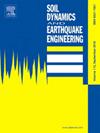Transfer learning-enhanced neural networks for seismic response prediction of high-speed railway simply supported bridges
IF 4.2
2区 工程技术
Q1 ENGINEERING, GEOLOGICAL
引用次数: 0
Abstract
The seismic analysis of Chinese high-speed railway bridge-track system (i.e., CRTS II ballastless track structure) is crucial for assessing vehicle operational safety and facilitating the seismic design of bridge bearings and piers. Currently, the design code utilizes bridge models for seismic design but neglects the influence of the track structure situated above the bridge, thereby overlooking the vulnerability of components in the track structure. Developing full models of bridge-track systems would significantly increase computational intensity and time costs, especially for assessing the seismic performance of high-speed railway bridge lines. To tackle this issue, this paper introduces a transfer learning-enhanced neural network to rapidly predict the seismic responses of bridge-track systems with limited labeled data. Pairs of bridge models, one with and one without the presence of track structure, are developed to establish the relationship of seismic responses between bridge-only and bridge-track system models. The seismic responses derived from bridge models are utilized as input, while seismic responses from bridge-track system models serve as output for training gated recurrent unit neural networks. Transfer learning techniques, based on Maximum Mean Discrepancy (MMD), are employed to facilitate feature transfer between various high-speed railway bridge-track systems with varying spans, pier heights, and different types of bearings. The application of transfer learning significantly decreases data acquisition costs while improving the predictive accuracy of neural networks. Analysis results indicate that the proposed framework displays strong generalizability across new models and is both computationally efficient and effective in predicting the seismic responses of high-speed railway bridge-track systems. This method provides an alternative for rapidly evaluating the seismic performance of high-speed railway bridge lines.
求助全文
约1分钟内获得全文
求助全文
来源期刊

Soil Dynamics and Earthquake Engineering
工程技术-地球科学综合
CiteScore
7.50
自引率
15.00%
发文量
446
审稿时长
8 months
期刊介绍:
The journal aims to encourage and enhance the role of mechanics and other disciplines as they relate to earthquake engineering by providing opportunities for the publication of the work of applied mathematicians, engineers and other applied scientists involved in solving problems closely related to the field of earthquake engineering and geotechnical earthquake engineering.
Emphasis is placed on new concepts and techniques, but case histories will also be published if they enhance the presentation and understanding of new technical concepts.
 求助内容:
求助内容: 应助结果提醒方式:
应助结果提醒方式:


